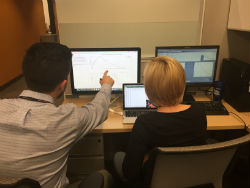Core Lab Facility
 Our Core Lab is located at the Perelman School of Medicine at the University of Pennsylvania. We have state of the art facilities and resources, including office space, computer stations, software and highly trained personnel. Our staff is experienced in clinical research, cardiac imaging, quantification processes, quality control methods, regulatory requirements, and administrative processes.
Our Core Lab is located at the Perelman School of Medicine at the University of Pennsylvania. We have state of the art facilities and resources, including office space, computer stations, software and highly trained personnel. Our staff is experienced in clinical research, cardiac imaging, quantification processes, quality control methods, regulatory requirements, and administrative processes.
Our Core lab has all the necessary software tools to perform advanced analyses, quantification and modeling of a variety of cardiovascular phenotypes of interest for cardiovascular research, which are particularly suitable for phase II proof of concept human mechanistic trials that target the arterial tree and/or the myocardium.
The Lab Director’s office is located in the Perelman Center for Advanced Medicine (Rm 11-138). Immediately adjacent to his academic office, there is a section of dedicated clinical research coordinator and core lab quantification space equipped with 10 PCs to accommodate our staff members. All stations have phone lines and access to a network of printers. There is also an internal server for file secure storage and sharing.
The Core Lab has additional office space for data and image analysis on the 8th floor of the Gates Building. This cardiac imaging processing unit is furnished with an additional 8 multi-monitor Windows workstations and two additional MAC workstations.
The Core Lab has a variety of software tools, both commercial and custom-made (in MATLAB, Python or C++) for quantification and modeling purposes. Our workstations are loaded with Matlab, CMR42 cardiac MRI analysis software, QMass cardiac MRI analysis software, EchoPac echocardiographic analysis software, Xcelera echocardiographic analysis software, TomTec echocardiographic analysis software, ImageJ software, Quipu vascular analysis software, Capillaroscopy analysis software, and multiple custom-developed graphic-user interfaces for analyses of arterial stiffness, arterial pulse wave analyses, pressure-flow analyses, quantification of arterial wave reflection, assessment of myocardial wall stress and myocardial mechanics, endothelial function, assessment of intraventricular pressure gradients with cardiac MRI, assessment of atrial function, modeling of diastolic filling, modeling of expired gas analysis data, and modeling of near-infrared spectroscopy data, among others. In addition to standard hardware interfaces, we have various ad hoc input devices (such as several Wacom Intuos 4 professional Pen tablet units) for adequate and time-efficient image analysis.
We also have various in-house developed graphic-user interfaces for LV segmentation, pressure-flow analyses, assessment of myocardial mechanics, modeling of expired gas analysis data, and modeling of near-infrared spectroscopy data.Our Core Lab has established collaborations with various experts not only at Penn but around the world, equipping us to handle even the most challenging aspects of cardiovascular physiologic modeling and quantification.
| Penn Cardiovascular Institute | Hospital of the University of Pennsylvania | Penn Medicine Research |
|---|
